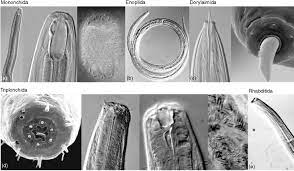In vitro multiplication of Panagrolaimus sp. (Nematoda: Rhabditida)
Abstract
Aim: Artificial culture systems of free-living nematodes can provide much information. Under the controlled condition, life cycles of free-living nematodes influence by temperature and food levels. The aim of the study was to find the best substrate for multiplication of the Panagrolaimus in the laboratory condition.Materials and methods: This study evaluated nine different media for in vitro mass production of Panagrolaimus. The media was including WA 1.5%, WA 1.5% + Goat butter oil, WA 1.5% + K2HPO4, SDA (Sabouraud 4% Dextrose Agar), SDA+ K2HPO4, SDA+ Goat butter oil, NA, NA+ K2HPO4, and NA+ Goat butter oil. The nematodes were counted after four, seven, and fourteen-day. The experiment was repeated two times.Results: Maximum multiplication of all the tested species was observed in WA 1.5% + Goat butter oil as 612.3 after 7 days. These results indicated that goat butter oil was a better medium for the laboratory multiplication of Panagrolaimus.Conclusion: The result indicated that goat butter is a good option to add the media to multiply the free-living nematodes in laboratory conditions.References
Chitwood D.J., Lusby W.R., Thompson, M.J., Kochansky, J.P., Howar O.W., 1995. The glycosylceramides of the nematode Caenorhabditis elegans contain an unusual, branched-chain sphingoid base. Lipids. 30, 567-573.
Cole, R.J., Dutky, S.R., 1969. A sterol requirement in Turbatrix aceti and Panagrellus redivivus. Nematol. 1 (1), 72-75.
De Ley, P., De Ley, I.T., Mundo-Ocampo, M., 1998. Identification of freeliving secernentea. Nematode workshop. Department of Nematology, University of California, Reverside.
Hieb, W.F., Rothstein, M., 1968. Sterol requirement for reproduction of a Free-living nematode. Science. 160, 778-780.
Inman, F.L., Singh, S., Holmes, L.D., 2012. Mass production of the beneficial nematode Heterorhabditis bacteriophora and Its bacterial symbiont Photorhabdus luminescens. Indian J. of Microbiol. 52(3), 316–324.
Kalita, R.M., George, J., Khataniar, L., Devi, G., Bhattacharyya, B., 2019. Mass multiplication of entomopathogenic nematodes in artificial media. J. Entomol. Zool. Stud. 7(5), 215-219.
Koohkan, M., Shokoohi, E., 2014. Mass Production and Prey Species of Mylonchulus sigmaturus in the laboratory. Acta Zool. Bulgarica, 66 (4), 555-558.
Kranti K.V.V.S., Kumar, G.N., 2018. Mass Multiplication of Entomopathogenic Nematodes on in vitro Solid Media. Int.J.Curr.Microbiol.App.Sci. 7(7), 3282-3292.
Lu, M.R., Lai, C.K., Liao, B.Y., Tsai, I.J., 2020. Comparative transcriptomics across nematode life cycles reveal gene expression conservation and correlated evolution in adjacent developmental stages. Genome Biol. Evol. 12(7), 1019–1030.
Ricci, M., Fifi, A. P., Ragni, A., Schlechtriem, C., Focken, U., 2003. Development of a low-cost technology for mass production of the free-living nematode Panagrellus redivivus as an alternative live food for first feeding fish larvae. Appl Microbiol Biotechnol. 60, 556–559.
Rothstein, M., 1968. Nematode biochemistry. IX. Lack of sterol biosynthesis free-living nematodes. Comp. Biochem. Physiol. 27, 309-317.
Seenivasan, E., 2017. Evaluation of different solid media for mass production of native entomopathogenic nematodes Heterorhabditis bacteriophora and Steinernema carpocapsae isolated from cotton fields. Int. j. zool. 3 (2), 45-50.
Shokoohi, E., 2021a. Morphological and molecular characters of Scutellonema brachyurus (Steiner, 1938) Andrássy, 1958 from South Africa. J of Nemato. 53, 1-13. https://doi.org/10.21307/jofnem-2021-027
Shokoohi, E., 2021b. First report of Mesocriconema sphaerocephalum (Taylor, 1936) Loof, 1989 associated with wild grass in Botswana. J of Nematol. 53, 1-5. https://doi.org/10.21307/jofnem-2021-013
Shokoohi, E., 2021c. First report of Bitylenchus ventrosignatus (Tobar Jimenez, 1969) Siddiqi, 1986 associated with wild grass in Botswana. J of Nematol. 53, 1-9. https://doi.org/10.21307/jofnem-2021-037
Shokoohi, E., Abolafia, J., 2021. Redescription of a predatory and cannibalistic nematode, Butlerius butleri Goodey, 1929 (Rhabditida: Diplogastridae), from South Africa, including its first SEM study. Nematology. 1-18. https://doi.org/10.1163/15685411-bja10089
Shokoohi, E., Abolafia, J., Mashela, P.W., 2020. Redescription of Paratrophurus anomalus (Rhabditida: Dolichodoridae) from South Africa. Nematology. 22(5), 543-554. https://doi.org/10.1163/15685411-00003322
Shokoohi, E., Abolafia, J., Zad, J., 2007. Nematodes of the order Rhabditida from Tehran province, Iran. The family Panagrolaimidae with description of Halicephalobus persicus sp. n. and a key to species of Halicephalobus timm, 1956. Nematology, 9, 693-711.
Shokoohi, E., Abolafia, J., 2019. Nematode Monographs, Rhabditida from Iran. Jaen University, Spain.
Tahseen, Q., Jairajpouri, M.S., Ahmad, I., 1994. Factors affecting hatching of the soil nematode Diploscapter orientalis. Nematol.medit. 22, 221-223.
Yhong-Hee Shim, J.U., Hee Chun, L., Eun-Young, L., Young, K., 2002. Role of Cholestrol in Germ-line Development of Caenorhabditis elegans. Mol. Reprod. Dev. 61, 358-366.
Zhang, S., Li, F., Zhou, T., Wang, G., Li, Z., 2020. Caenorhabditis elegans as a Useful Model for Studying Aging Mutations. Front. Endocrinol. 11, 1-9.

Copyright (c) 2021 Transylvanian Review

This work is licensed under a Creative Commons Attribution-NonCommercial-NoDerivatives 4.0 International License.



